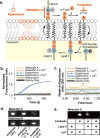Culture-independent discovery of the malacidins as calcium-dependent antibiotics with activity against multidrug-resistant Gram-positive pathogens
- PMID: 29434326
- PMCID: PMC5874163
- DOI: 10.1038/s41564-018-0110-1
Culture-independent discovery of the malacidins as calcium-dependent antibiotics with activity against multidrug-resistant Gram-positive pathogens
Abstract
Despite the wide availability of antibiotics, infectious diseases remain a leading cause of death worldwide 1 . In the absence of new therapies, mortality rates due to untreatable infections are predicted to rise more than tenfold by 2050. Natural products (NPs) made by cultured bacteria have been a major source of clinically useful antibiotics. In spite of decades of productivity, the use of bacteria in the search for new antibiotics was largely abandoned due to high rediscovery rates2,3. As only a fraction of bacterial diversity is regularly cultivated in the laboratory and just a fraction of the chemistries encoded by cultured bacteria are detected in fermentation experiments, most bacterial NPs remain hidden in the global microbiome. In an effort to access these hidden NPs, we have developed a culture-independent NP discovery platform that involves sequencing, bioinformatic analysis and heterologous expression of biosynthetic gene clusters captured on DNA extracted from environmental samples. Here, we describe the application of this platform to the discovery of the malacidins, a distinctive class of antibiotics that are commonly encoded in soil microbiomes but have never been reported in culture-based NP discovery efforts. The malacidins are active against multidrug-resistant pathogens, sterilize methicillin-resistant Staphylococcus aureus skin infections in an animal wound model and did not select for resistance under our laboratory conditions.
Conflict of interest statement
Figures




Comment in
-
Discovering antibiotics from the global microbiome.Nat Microbiol. 2018 Apr;3(4):392-393. doi: 10.1038/s41564-018-0135-5. Nat Microbiol. 2018. PMID: 29588534 No abstract available.
References
-
- O’Neill J. The Review on Antimicrobial Resistance. 2016;2016
-
- Tringe SG, et al. Comparative metagenomics of microbial communities. Science. 2005;308:554–557. - PubMed
-
- Strieker M, Marahiel MA. The structural diversity of acidic lipopeptide antibiotics. Chembiochem : a European journal of chemical biology. 2009;10:607–616. - PubMed
-
- Jung D, Rozek A, Okon M, Hancock RE. Structural transitions as determinants of the action of the calcium-dependent antibiotic daptomycin. Chemistry & biology. 2004;11:949–957. - PubMed
Publication types
MeSH terms
Substances
Grants and funding
LinkOut - more resources
Full Text Sources
Other Literature Sources
Medical
Research Materials
Miscellaneous

